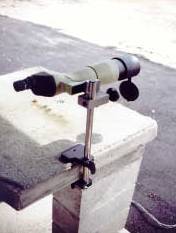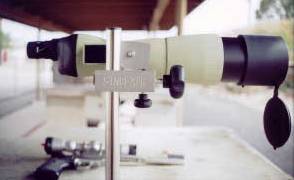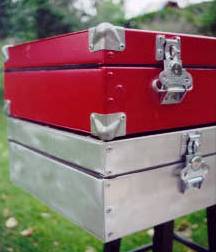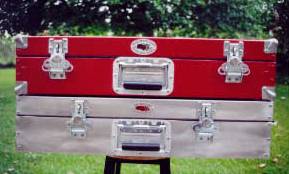|
Hodgdon Powder Company
has issued a product recall for one lot
(LOT# 103080221)
of its very popular Lil Gun smokeless powder. What happened was that
one 50 lb keg was mislabeled as Lil Gun when it was actually something else.
Those 50 pounds of powder were then packaged in one pound Lil Gun containers and
shipped. As a result, the entire 850 lb lot had to be recalled.
If you
have powder from the recalled lot,
DONíT USE IT.
It
has a much, much faster burning rate and "can cause personal injury to the user
and/or the bystander and damage the firearm".
Call Hodgdon and theyíll send you
a prepaid D.O.T. approved container to ship the powder back to them. Theyíll
then send a replacement one pound can back to you. There is no cost to you what
so ever.
I happened to have two pounds of Lil Gun on hand and so immediately
checked to see if they were from the affected lot. After carefully looking over
the label, I couldnít find a lot number anywhere. I even looked under the cap. I
finally noticed an orange sticker on the bottom of one of the cans and it had
what might have been a lot number on it. However, I couldnít be sure whether it
was or not. The second can had no sticker at all. Probably fell off somewhere.
Just to make sure of things, I called Hodgdon at 1-800-622-4366 and talked to a
very nice customer rep. He explained that the orange sticker did indeed have the
lot number on it. I asked him then about the can with no sticker and he said the
safest thing to do would be to send it back and have the powder replaced.
So hats off to Hodgdon for doing the right thing in a sticky
situation. Itís unfortunate that the executives of other, much larger companies
like Enron, Arthur Anderson, and American Airlines don't have the same ethics
that we commonly find in the shooting industry.
Sinclair Bench Scope Stand - Silhouette shooting is a reloaders sport. Weíre always experimenting
to find the magic combination of powder, bullet, primer, and case for our guns.
In turn, it also means that weíre constantly testing the accuracy of those loads
off the bench. When bench shooting handguns, weíre usually using relatively low
powered pistol scopes, and so clearly seeing bullet holes on distant targets can
be some times difficult, especially if weíre using small caliber bullets. Thatís
where a good spotting scope comes into the picture, and as I have said many
times, a good spotting scope needs a good mount to be fully effective.
For years Iíve been using a small bench tripod for my spotting scope
and it worked fine - until I started using a big Nikon 80mm Sky & Earth model.
The Nikon is just too big and heavy for the little tripod. It
definitely became somewhat unstable and tippy whenever the big scope got screwed
on. The last thing I want is for my nice scope to fall off the bench because the
little tripod was unbalanced.
Another problem with the tripod was the fact that it took up a lot of
room on the bench. It always got in the way of things and I always seemed to be
bumping it with my elbow. That added even more to my concerns about knocking it
over. Additionally, I never seemed to be able to get it in a convenient position
where I could look through it without changing my position. I would take a shot
and then would have to pull the scope over to where I could take a look, and
then have to push it back out of the way when I was finished. It was a hassle -
no doubt about it.
Thereís a fair number of benchrest shooters at my range, and a few of
them use home made scope stands that clamp on to the sides of the concrete
shooting benches. When using the clamping type stand, it and the attached scope
can be easily positioned so that the shooter can take the shot and then move
their head just a little bit over to the side and look at the target with no
interference. Since the stand is clamped on the side of the bench top, it
doesnít take up room on the top or get in the way. It seemed to be a very
practical set up.
Having practically memorized my latest
Sinclair catalog
(260-493-1858), I recalled that my favorite precision reloading store sold
exactly this kind of product and so I thought Iíd look into it. The first
impression you get is that this thing is built like an Abrams tank. They donít
skimp on materials at Sinclair. The elevation post is nearly an inch in diameter
and is a 18" heavy tube of seamless stainless steel sealed with plastic caps at
both ends. The two clamping plates that slide up and down on the tube are over
three quarters of an inch thick and are anodized black aluminum plate. The
bottom plate also has a large plastic handled threaded screw in its bottom.
Adjust the plates for the thickness of the bench top, slide the mount
on and turn in the large bottom screw. I guarantee that sucker not going to
move. In fact, once I got it tightened up, I grabbed the top of the post and
gave it a couple of good yanks and pulls, and didn't even get a wiggle. Very
nice.
|

|
|
"Rugged convenience is the
hallmark of the Sinclair
scope stand" |
|
The scope head mount fits over the top of the post and can be easily
slid up and down to the ideal height. Once in place, a large horizontal plastic
knob is turned in to secure it in place. You now mount your scope on the hard
anodized head with an allen head bolt.
|

|
|
"Vertical adjustments are
very smooth and precise" |
|
This was my only, and rather minor, gripe. The necessary Allan head
wrench wasnít provided (no big deal since I have a ton of them) but I would have
preferred another plastic knob type screw for this function. It just would have
been easier and faster but, as I said, itís a small thing.
Once the scope is attached, loosen the large knob slightly to allow
the scope to be moved from right to left and then tighten up again when lined up
on the target. The mounting head also features a very nice vertical adjustment
mechanism. Just turn another plastic handled vertical knob underneath to make
the scope move up or down. The spring loaded mechanism allows very smooth and
precise changes in elevation.
After using the scope stand a couple of weeks now, I'm sincerely sorry
I didnít get one earlier. Like all Sinclair products, itís very strong,
extremely well made, uses first class materials, and is highly functional and
convenient to use. It even fits in my Uncle Mikeís police range bag. Cool.
TC Says No More 10" Barrels - TC has quietly decided to stop production of ten inch barrels. As you
might know, the long delayed G2 Contender will be equipped with 12 and 14 inch
barrels only. If someone wants a 10" barrel for a Contender, theyíll have to buy
it from Fox Ridge, the TC custom shop. Of course, the cost is higher.
Frankly I think this stinks. There is no reason for Thompson Center to
stop making 10" barrels since there is nothing mechanically different between a
Contender barrel and a G2 barrel. I know someone at TC will say something like
"Thereís not enough business in 10" barrels to justify their continued
production". On the other hand there is not a shred of evidence that 12" barrels
are going to sell any better than 10" barrels. In fact they might sell even
fewer, as any handgun hunter can tell you that carrying a 10" TC in the field is
a lot more convenient than a 12 or a 14 inch. Additionally, any increase in
velocity between a 10 and 12 inch barrel really isnít that significant. I donít
know for a fact, but this suspiciously looks like a way to force people who use
10" barrels (you and me) to pay more for them by coercing them to go to Fox
Ridge.
Another rather serious problem arises for our Canadian silhouette
shooters. Fox Ridge absolutely refuses to ship barrels to Canada. They say itís
not worth the trouble. On the other hand, TC will ship to Canada. Figure that
out. Now you have a situation so that even if a Canadian shooter is willing to
pay the extra money for a Fox Ridge 10" barrel, they still canít get one.
Fortunately, there should be a decent supply of TC 10" barrels still in the pipe
line, but theyíre not going to last forever. This also is going to present our
Board with a situation where our Canadian shooters will either have to forgo the
Production Class or get some kind of exemption on barrel length. What a mess. I
think that every silhouette shooter that owns a 10" barrel should call TC and
ask that they resume production.
Tell Freedom Arms What to Do - I was talking to Bob Baker, President of
Freedom Arms, a couple of
months ago and during the course of the conversation, Bob mentioned that they
were tossing around the idea of offering a different Bear Track gun case in
addition to the current "Expedition" model. The new case would be exactly the
same as the current case with the exception that it wouldnít have the steel
corner protectors, or the polyurethane protective coating featured on the
current model. Instead, it would have a brushed aluminum finish. The cost would
be lower as well.
Bob then asked me if Iíd like to evaluate a prototype case and gather
shooter reaction to it. If the reaction was positive, they might go ahead and
offer it. If the reaction was neutral or luke warm, theyíd leave things as they
are. Since I already owned one of the regular Expedition silhouette cases, I
thought a comparison of the two models would be interesting. About a week later
a new double layer silhouette case showed up.
The case I own is one of the very early Bear Track models and has a
fire engine red powder coat over the aluminum. I really like this case and
wouldn't give it up for anything. It was about a year after I bought mine, that
Bear Track started offering the poly instead of the powder coat treatment. The
poly material is a much tougher and more durable coating. While the powder coat
is fairly abrasion resistant, thereís almost no scratch resistance and I have to
be somewhat careful when packing the case in the truck of the car to avoid
getting it scratched up.
When the case arrived, I immediately saw that its construction was
almost exactly the same as my older case except as mentioned, the case was just
naked aluminum with a brushed finish and no corner protectors.
|

|
|
"The absence of corner
protectors on the prototype case is very apparent" |
|
Letís talk about the uncoated aluminum first. As most owners of
regular aluminum cases know, the metal surface will eventually oxidize and turn
dull gray. If youíre fussy about this, there are chemical materials you can buy
to remove the oxidation and restore the original bright surface. If you're not
fussy, itís no big deal then. However, that oxidation can rub off on the seat
cushions of your car. So if you have an aluminum case with a dull surface, itís
best to transport it in the trunk and not in the passenger area of your vehicle.
Now, corner protectors. They serve two functions. One, they protect
the corners from being crushed if the case should be dropped on a hard surface
from a height. However, this really shouldnít be a problem for most people.
Additionally, the channel box construction already makes the corners very strong
and impact resistant. Secondly, they act to elevate the sides and bottom of the
case off of the ground and thus prevent the case from getting scratched up.
Instead of corner protectors, the new case had four little rubber
doughnut type legs riveted on the bottom. By doing away with the steel corner
protectors and the poly coating, the weight of the case is reduced somewhat.
However, the new rubber legs protect only the bottom of the case when itís
standing upright. There are no corresponding legs on the side. So if you should
lay the case down (as most people will to open it) it will get scratched up
eventually. This may be a concern for some, and for others, who regard a gun
case as just another kind of tool box, itís not a problem.
Another possible disadvantage of the rubber legs is that if you ship
the case on an airline, thereís a possibility that the luggage handling machines
could tear them off. If you never ship guns this way, itís obviously not a
problem.
Both cases share the same three oversized stainless steel hinges,
super heavy duty cam latches, super strong channel box construction, same
thickness on the aluminum, same tamper proof hinge pins, and the same super
dense foam on the inside. Indeed, the prototype case is better than any other
case Iíve seen other than the Expedition model and I think that anyone would be
proud to have one.
|

|
|
"The prototype case
(bottom) has almost all of
the features of a standard case" |
|
Would I make any changes to the prototype? Well, Iíd put the corner
protectors back on to protect the case from getting scratched up. Iíd also not
bother with the brushed finish to keep the cost down. Thatís just my opinion
though.
OK. Now the big question. How much would the new case cost. Donít know. It
all depends on what the final design of the case will be.
So whatís YOUR opinion? Hereís where you can have a direct input.
E-mail me at
tspotti@worldnet.att.net
and let me know what you think Freedom Arms should
do and Iíll pass the word on. Shooters donít get asked for input on a possible
new product very often, so let me hear from you. If I get only a couple of
e-mails, you can bet that will be the end of it. If I get a couple of hundred,
the chances are probably pretty good that the new case will be produced. So
whatís it going to be?
Slik 2100 Pistol Grip Tripod Ball Head - A couple of months ago, I did an article on tripods which featured a
number of photos of the Slik model 800 DX to illustrate various desirable
features that a quality tripod should possess. In the article I also discussed
the various types of tripod heads that were available and their merits. Among
them was a ball head type which is generally recognized as the most flexible as
it allows you to easily point a scope in almost any direction very effortlessly
and quickly.
Well my good friend Dr. Jim Williams owns a Slik 800 DX, and through
some very astute internet research found a Slik pistol grip type ball head for
his tripod at a very reasonable cost. By the way, the head will fit any standard
tripod. To operate the head after attaching your scope or binoculars, pull the
spring loaded lever and the head will rotate to almost any position including a
90 degree horizontal. Pointing is extremely easy and fast. Release the lever and
the scope is locked in place. The head has a capacity of carrying 11 pounds and
has a 3 year warrantee.
Iíve seen this head selling for nearly $200 in some places, but by
going to
(http://www.digitalfotoclub.com)
you
can pick it up for around $63 plus shipping. Heck of a deal. They also have
other ball head type products for as low as $25 and up. So if you want to
upgrade your tripod, this is the way to do it. As they say, pretty Slik. Uhhh, I
meant slick.
|
|
![]()